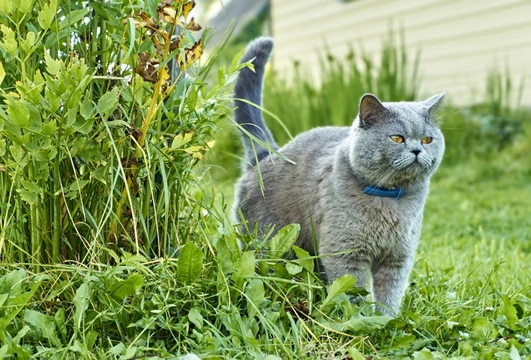
What makes cats bush up their tails?
Cats are well renowned for being enigmatic animals, and their body language and methods of communication tend to be much more subtle than that of dogs, who tend to wear their hearts on their sleeves when it comes to letting you know how they feel!
However, cats do of course have their own fluent body language and a wide range of different methods of communication that can tell you what your cat is thinking, feeling or doing if you know how to read them effectively, and some of the most distinctive forms of feline communication involve the tail.
A quickly swishing tail usually indicates annoyance, but of course the other main tail-related communication you may see your cat displaying is a bushed up tail, with all of the tail fur standing on end and often looking quite comical. The exception of course comes in the form of hairless cat breeds like the Sphynx, who don’t have fur to bush up-but who may get the appearance of goose bumps as their bodies still go through the same motions!
Most cat owners have a basic grasp of why cats bush up their tails, but there can in fact be several different reasons for this behaviour-and we will look into each of them in more detail within this article. Read on to learn more.
Anger/annoyance
Virtually all cat owners know that a cat will bush up their tail to its fullest extent if the cat is angry or annoyed, and if you have more than one cat and they are having a showdown, one or both of them is likely to bush up their tail in warning and as part of threat display.
This serves the purpose of making the cat look larger and more imposing to their opponent, and as a secondary effect, serves the purpose of making the core of their tail harder to latch on to, helping to protect them from bite and scratch injuries.
Sometimes when two cats are playing and one has had enough and wants to be left alone-or they don’t like the way the game is going and the fact they are not winning-the beginnings of the bushed up tail can indicate that the mood has soured. Additionally, if your cat has been outside and comes stalking back in with a bushed up tail and a wary expression, they have probably successfully seen off an opponent-or beaten a strategic retreat!
Fear
Cats will also bush their tails up if they are afraid, which again, is designed to deter a potential attack by making the cat look bigger and less of a weak target, in an attempt to discourage the cause of their fear from taking them on. They are also apt to face the opponent side on to further make their profile larger, and they won’t take their eyes off the threat for a minute!
You may see your cat’s tail bushed up in this way if they are facing a dog, or if something like fireworks or other loud noises scares them.
Play
Watching two cats or kittens playing together or playing interactively with your own cat can be highly amusing and entertaining for both of you, and during play you can observe your cat displaying mimicry of all sorts of hunting, stalking and attacking behaviour.
This may include a bushed up tail if your cat is finding catching that piece of string a challenge, or if they are playing a game that involves chasing or pouncing on another cat!
Tactile sensation
If you are brushing your cat and this is something your cat really enjoys, their fur and skin is apt to react to the stimulation of the tactile sensations that brushing promotes, particularly if you are brushing hard-to-reach areas or particularly tickly spots like the base of the tail.
Your cat’s tail probably won’t bush up to the same extent that it will if they are angry or afraid, but just as pleasant tactile sensations can cause goose bumps in people, so too can the same effect occur in cats, which causes the follicles to stand up and bush up the fur.
Mating rituals
Finally, feline mating rituals are often prolonged and elaborate-as well as of course very noisy! Even when a female is in heat and ready to mate and a tom cat is nearby, they are unlikely to simply get on with it, and a reasonable amount of yowling, swiping, chasing and wrestling are apt to occur first.
Either the male or the female or both may bush up their tails during the mating ritual before the couple seal the deal, as it were, and this is just one of the many manifestations of mating behaviour that the couple can display. Of course, if the female is not up for mating, the bushed up tail can be used as a warning to the male to keep away as well!



